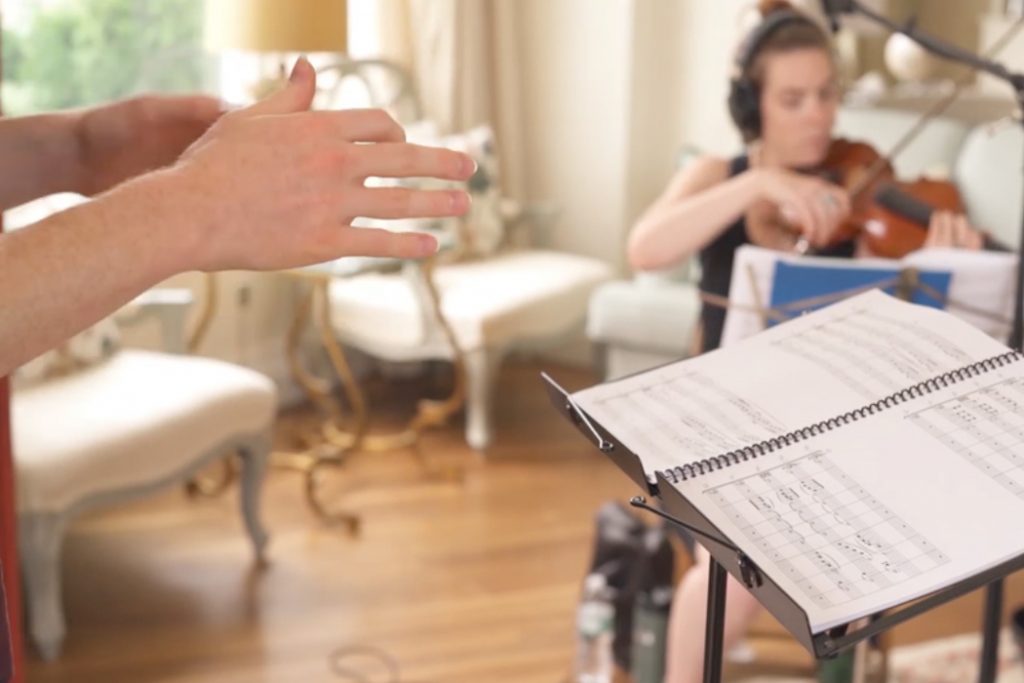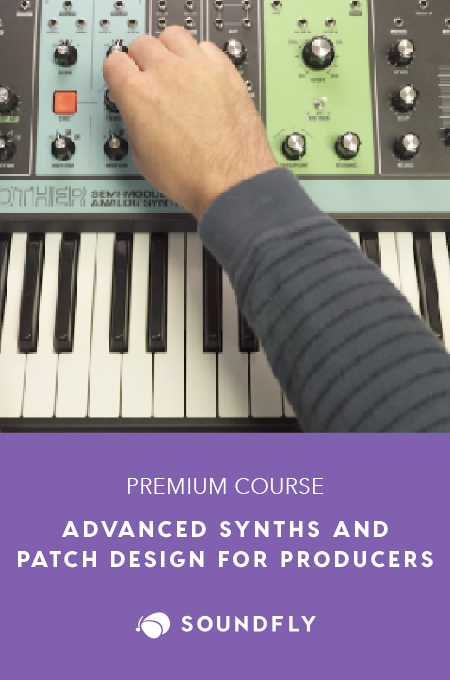+ Soundfly’s Intro to Scoring for Film & TV is a full-throttle plunge into the compositional practices and techniques used throughout the industry, and your guide for breaking into it. Preview for free today!
The two have gone hand in hand long before the cinematic masterworks of Hollywood composers like Copeland, Morricone, Rota, Mancini, Zimmer, and Williams, to name only a select few. Back when silent cinemas hired live accompanists to set music to the silent pictures of the day, the music was just as fundamental a part of the experience as it is today.
A film’s score can often elevate the quality of the original film to new heights. Most famously; George Lucas was met with sordid reviews after showing the original Star Wars edit to his fellows at the Director’s Guild in Hollywood. When he showed the same exact cut with John Williams’ score several months later (good looking out Steven Spielberg!), the same group of directors erupted with excitement, calling the film a “masterpiece!”
If you’re familiar with film scoring or ever taken a class on the subject, you’ll know that music serves several distinct and important purposes in supporting and reinforcing the narrative development of a film. Music can be used to underscore the action itself, create tension/release in anticipation of coming events, and to accent actions with musical cues (this is sometimes referred to as “mickeymousing”).
Most prevalent amongst modern film composers is to also score the emotional subtext being experienced by the characters beneath the action on camera, giving us a unique and secondary point of view that can’t otherwise be communicated visually or textually by the actors on screen.
I’ve been thinking about this idea as a compositional challenge.
- What if we musicians, producers, and composers, challenged ourselves to write a chord sequence to score an imaginary dramatic scene, as a form of practice?
- How would that change the way we approached the harmonic and melodic writing process?
- And how might that get us to think more creatively, more visually, about a song or piece’s development?
I started imagining my scene first. My imaginary film scene we’re going to score comes from a hybrid spy/heist movie. I’m thinking of a darker version of Ocean’s Eleven meets Daniel Craig-era James Bond.
A quick aside: I personally really do love the way that David Holmes revived the post-Golden Age scoring techniques of composers like Henry Mancini, incorporating elements of jazz, pop, and afro-cuban music in Ocean’s Eleven. Very cosmopolitan, slick and oozing with swagger, like The Pink Panther in Harlem.
My main reference for this venture however, will be Lalo Schifrin, known best for the Mission: Impossible TV series.
One of my favorite themes ever is “The Plot,” used when Mr. Briggs, Phelps, and their crews are preparing for their impossible missions. I love the instrumentation, the leggera of the percussion and use of the minor 2nd (implying the Phrygian mode).
Now onto my imaginary scene. Let’s dive right in to the action!
+ Read more on Flypaper: “The Cutting Edge: 10 Film Scores That Push the Boundaries of Composition.”
Here’s the Scene
Our imaginary scene is set somewhere in mountainous Europe, like Montenegro or Switzerland. Our band of vigilantes is preparing to rob a train, in search of an object or instrument that will serve them in their quest.
It’s dreary, and dangerous, the crew prepares to rappel down a mountainside to board at high speed. Someone’s life hangs in the balance, the stakes are high. We glean close-up shots of each character, as the rain begins to quicken and the train rapidly approaches. As the heist progresses, the theme builds to a crescendo before making a wild left turn to something more sinister when things inevitably get more complicated than anticipated. If they didn’t, there would be no movie.
The Score
To properly underscore the intensity of the scene, in addition to illuminating the underlying emotions being experienced by the characters, the progression will need to use tension and release, with an emphasis on ramping up that tension in this particular moment.
So here’s my chord progression:
C7#11 – C7b13 – Bb+/C – Cmaj7#5
Csus2/G – Ab(add6) – G – Fdim
Okay, admittedly these are weird progressions. So, what the heck is going on here!?

In the first half, I’ve chosen to approach the progression modally, using a static tonic with different chord extensions to add various colors while also making things quite uncomfortable.
As such, we end up borrowing chords from three different keys. I feel this is the best way to create tension as the characters board the train itself, and to typify the various discrete emotions being experienced on screen. There’s mystery and intrigue, but there’s excitement as we watch the plot move forward.
Everything revolves around the shared drive to accomplish the mission (exemplified by the tonic), but each individual character’s backstory, personal vendettas and fears come into play. This might also give me the opportunity to use some very jarring instrumentation, like metallic percussion and booming low-end to evoke the characteristics of the industrial train; burgeoning death and the sound of steel on steel.
I imagine the tonic note (C) being played as stabs by the brass and timpani, while the upper chord tones are struck by strings and tuned percussion, in the vein of Prokofiev or Stravinsky.
Theoretically, C7#11 is taken from a harmonized G melodic minor scale. The next chord, C7♭13 is taken from F melodic minor. B+/C is also actually taken from G melodic minor (it’s the chord built on the third scale degree, Lydian augmented). The last chord, Cmaj7#5 comes from A melodic minor.
As the crew clears the first hurdle of boarding the high speed train in the inclemate weather, the tone shifts to one that is more fluid and introduces the possibility of success, call it “hope” (for lack of a better term in a cool-guy spy movie).
+ Read more on Flypaper: “What the “Tristan Chord” Is and How to Use It.”
We can imagine the tactical team dropping into a dark train car, turning on their night vision goggles and raising their weapons. They deploy some fancy futuristic gadget to aid in their quest, and after some tepid silence and de-tuned kalimba noises, the second part of the progression begins.
The tonal center is now C minor. The first chord is suspended. This then climbs to the IV chord, A♭(add6). The fifth of the Cm chord (G) moving up to (A♭) as in a line cliché creates some lift and hope, which turns to doubt on the next chord, G (no seventh). The final chord, F diminished (substituted for F minor), tells us things are definitely still not okay.
The shift to a more diatonic chord progression here helps to alleviate some of the gross tension created by the first set of chord changes. However, the bass moving from G – A♭ back to G makes us feel a bit deflated as the progression concludes. This is used to create immediate rise and fall in the progression. The listener wishes the line cliché to continue climbing (ie: G – A♭ – A – B, etc.), as in James Bond and others. The bass moving back down to G as soon as it lifts places a withholding on triumph.

The characters move through the train seamlessly, executing their mission. That is until they get caught, at which time they’re forced to improvise and enter into hand to hand combat to contain the threat.
In this instance we return to the clunky dissonance of the original progression, with the diatonic progression re-entering when the team clears the room and inches closer to the end of their mission.
This exercise is a fun, and difficult, way to practice your scene scoring chops, and workshop your ability to tie a song’s music to the emotional, dramatic material of the story, whether told through lyrics or a scene. Try it out!
Have you checked out Soundfly’s courses yet?
Continue your learning with hundreds of lessons by boundary-pushing, independent artists like Kimbra, Ryan Lott & Ian Chang (of Son Lux), Jlin, Elijah Fox, Kiefer, Com Truise, The Pocket Queen, and RJD2. And don’t forget to try out our intro course on Scoring for Film & TV.




